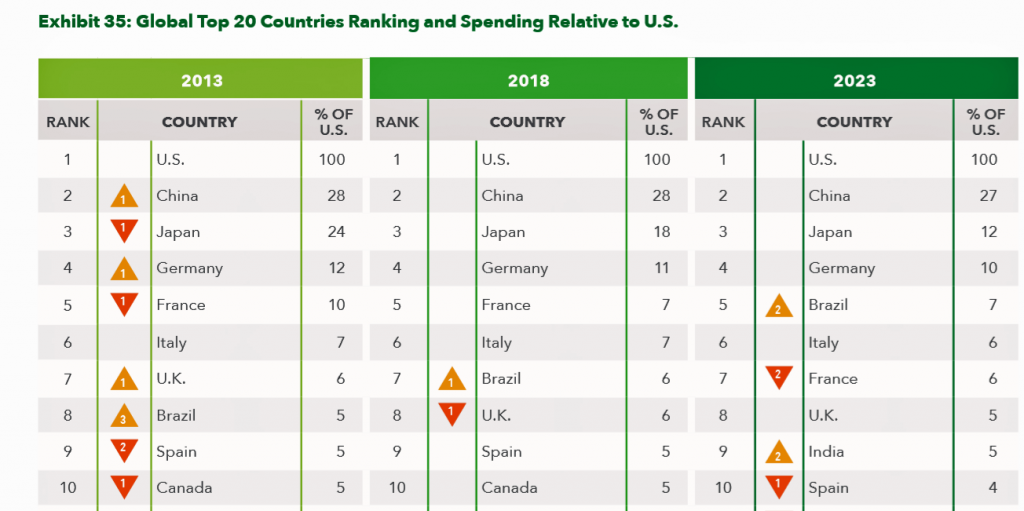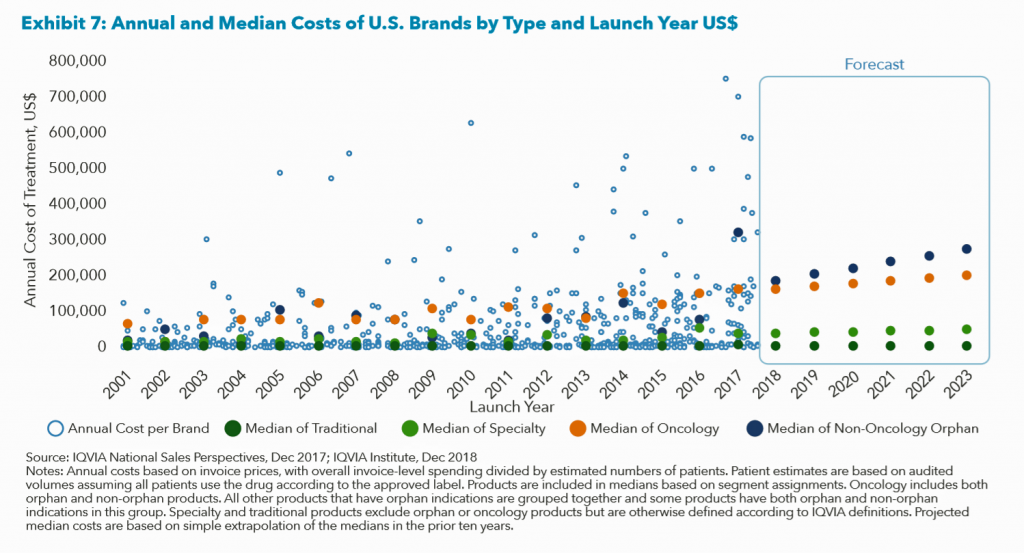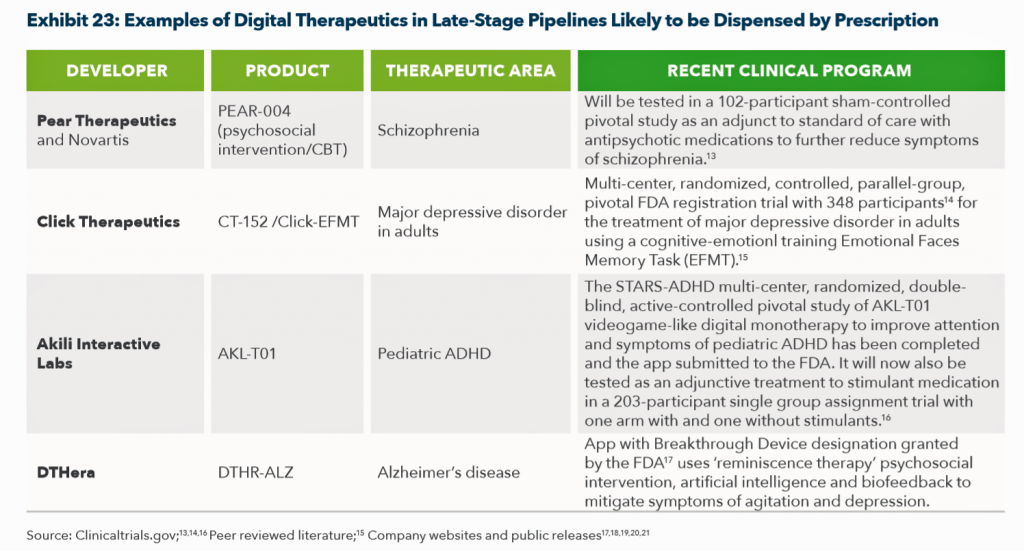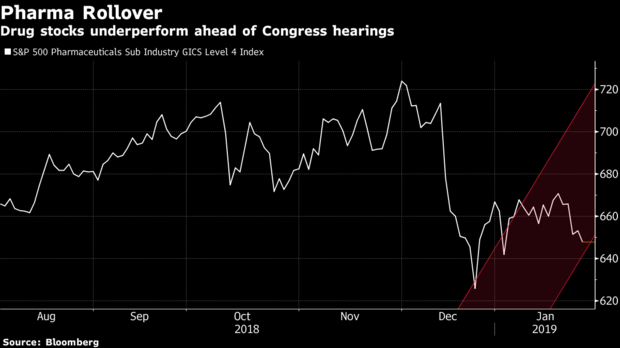Today, as Congress kicks off hearings about the cost of prescription drugs in the United States, IQVIA published its 2019 report on The Global Use of Medicine in 2019 and Outlook to 2023. The top-line of the research is the robust pharma market growth will be driven by two factors, and limited by two others: spending in the U.S. and emerging markets (coined “pharmerging” by IQVIA) will push up spending, while limiting factors on growth will be increasing generics and expiration of brand patents.

The U.S. will continue to be the number 1 prescription drug spender in the world to 2023, IQVIA forecasts, shown in the first chart where I clipped the top 20 to 10 top spenders. The U.S. will be followed by China, Japan, Germany, and Brazil in 2023.
For context and comparison, note that the U.S. has some 326 million citizens, and China nearly 1.4 billion. China will have spent just over one-fourth of what the U.S. paid for prescription drugs in 2018, with roughly four times the number of health citizens.
The rate of growth of Rx spending looks fairly flat from 2019 to 2023, the second bar chart illustrates, with net growth of spending just over 4% by 2021-2023.
This moderate growth rate is a moment in time, because IQVIA expects a pipeline of new and more expensive products to be launched as older brands continue to come off-patent — the moderating force on the price-driven growth of the new specialty drugs.

The second chart illustrates costs of drugs by type and launch year, showing that the median list price for oncology and orphan drugs (defined as medicines that treat fewer than 200,000 patients globally) could exceed $200,000 per year by 2023. Thus, while the costs of traditional drugs aren’t increasing far above the rate of inflation, the new-new therapies are much higher-priced.
See the dark blue dot in 2023 north of the other dots, representing the median costs for a non-oncology drug with orphan status priced around $300,000.
Other key trends to expect leading to 2023 will be:
- The rise of patient advocacy roles in pharma companies
- The growing adoption of artificial intelligence and machine learning by pharma companies to drive more efficient drug discovery
- More philanthropic organizations targeting neglected tropical and public health diseases
- The increased use of
 real-world evidence (RWE) and patient involvement in clinical trials
real-world evidence (RWE) and patient involvement in clinical trials
using consumer-generated technology.
IQVIA rightly calls out digital therapeutics (DTx) in this year’s report, noting the growth of mobile apps and digital tools submitted to the FDA for clearance or approvals. The first FDA cleared DTx was reSET from Pear Therapeutics, cleared in November 2018. This is used for the treatment of substance use disorder and is the first of many conditions Pear is developing in the mode of software-as-medicine to complement the usual standard of care.
DTx companies have been striking partnerships with pharma companies to help them “surround the pill” with service. We can anticipate more of these collaborations going forward as pharmas look to add value beyond the pill, and innovators leverage peoples’ everyday relationships with and trust in consumer technologies.
The limiting factor here will be proving the evidence for DTx on a case-by-case basis. Thus far, the FDA has been welcoming to these concepts.
Health Populi’s Hot Points: I introduced this post noting today is the first of what will be a long and deep look into prescription drug pricing in America. IQVIA recognizes that, “the (U.S.) Federal government has proposed a sweeping set of pricing reforms for government programs with varying levels of impact and probability of being enacted.” Furthermore, “the next five years likely pose a number of challenges to biopharmaceutical companies, with payer actions on prices looming.”

The last chart was published today in Bloomberg, observing that drug stocks were under-performing ahead of today’s first Congressional hearing on the topic of drug prices.
The Democratic-led House of Representatives may be blamed for this hazing, but in fact voters across political party have been interested in the Federal government taking more assertive and proactive action for prescription drug prices. Polls among voters for several years have found that this issue is a concern for majorities of Democrats, Independents, and Republicans.
In an America lacking consensus across the wide range of issues on voters’ minds, health care costs – and particularly Rx costs and prices – rank top of mind for voters and House Democrats.
Americans have come to learn the role they play in subsidizing the cost of drugs and their development for the world’s health citizens. Note my math on the China ratio of 1:4 dollars spent on prescription drugs versus the U.S., with over four times the number of people.
This topic will inevitably be part of ongoing political debates as we lead up to the 2020 Presidential election. The patient is the consumer is the payor of health care, including prescription drugs at the point of purchase.
The post In 2023, the U.S. Will Still Be the #1 Prescription Drug Spender in the World, IQVIA Forecasts appeared first on HealthPopuli.com.
In 2023, the U.S. Will Still Be the #1 Prescription Drug Spender in the World, IQVIA Forecasts posted first on http://dentistfortworth.blogspot.com
No comments:
Post a Comment